trailer Hyundai Accent 2011 Owner's Manual
[x] Cancel search | Manufacturer: HYUNDAI, Model Year: 2011, Model line: Accent, Model: Hyundai Accent 2011Pages: 282, PDF Size: 14.82 MB
Page 14 of 282
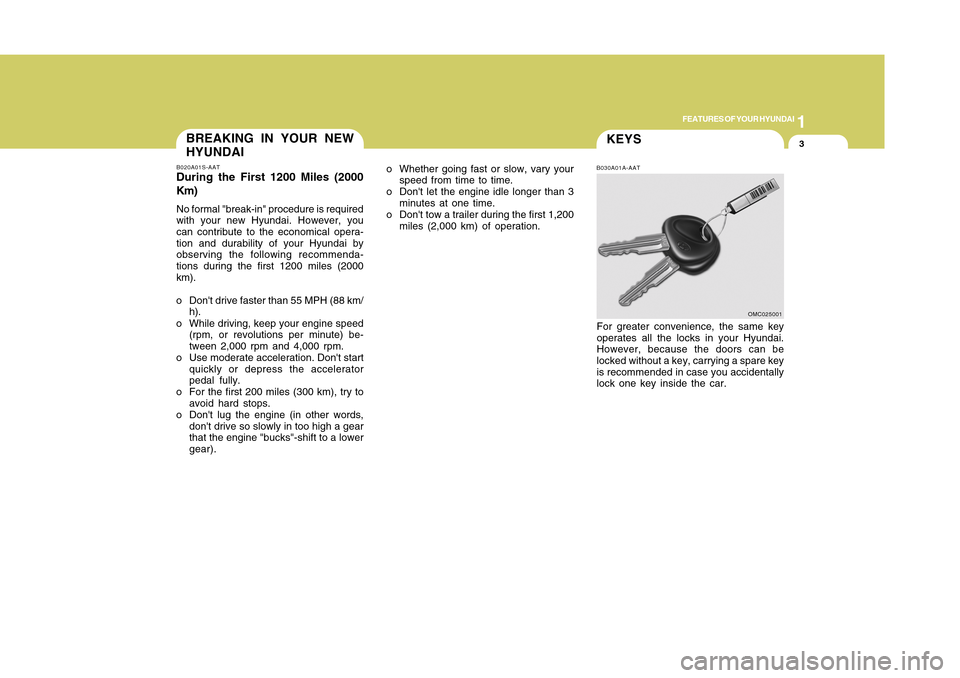
1
FEATURES OF YOUR HYUNDAI
31
FEATURES OF YOUR HYUNDAI
3
BREAKING IN YOUR NEW
HYUNDAIB020A01S-AATDuring the First 1200 Miles (2000
Km)No formal "break-in" procedure is required
with your new Hyundai. However, you
can contribute to the economical opera-
tion and durability of your Hyundai by
observing the following recommenda-
tions during the first 1200 miles (2000
km).
o Don't drive faster than 55 MPH (88 km/
h).
o While driving, keep your engine speed
(rpm, or revolutions per minute) be-
tween 2,000 rpm and 4,000 rpm.
o Use moderate acceleration. Don't start
quickly or depress the accelerator
pedal fully.
o For the first 200 miles (300 km), try to
avoid hard stops.
o Don't lug the engine (in other words,
don't drive so slowly in too high a gear
that the engine "bucks"-shift to a lower
gear).o Whether going fast or slow, vary your
speed from time to time.
o Don't let the engine idle longer than 3
minutes at one time.
o Don't tow a trailer during the first 1,200
miles (2,000 km) of operation.
KEYSB030A01A-AATFor greater convenience, the same key
operates all the locks in your Hyundai.
However, because the doors can be
locked without a key, carrying a spare key
is recommended in case you accidentally
lock one key inside the car.
OMC025001
Page 157 of 282
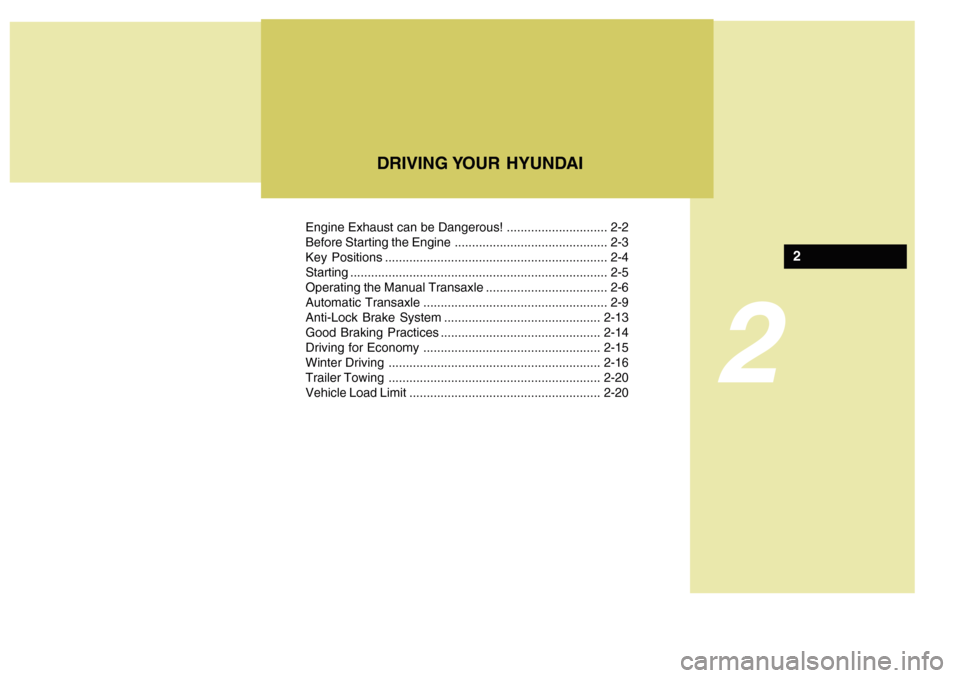
Engine Exhaust can be Dangerous! ............................. 2-2
Before Starting the Engine ............................................ 2-3
Key Positions ................................................................ 2-4
Starting..........................................................................2-5
Operating the Manual Transaxle ................................... 2-6
Automatic Transaxle ..................................................... 2-9
Anti-Lock Brake System.............................................2-13
Good Braking Practices..............................................2-14
Driving for Economy...................................................2-15
Winter Driving.............................................................2-16
Trailer Towing.............................................................2-20
Vehicle Load Limit.......................................................2-20
DRIVING YOUR HYUNDAI
2
2
Page 176 of 282
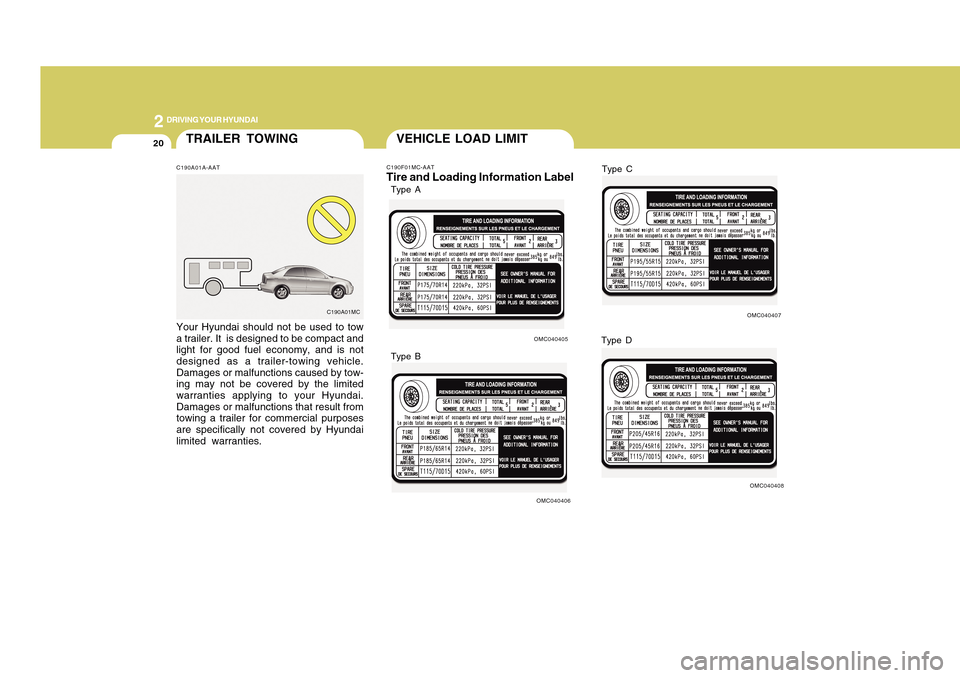
2
DRIVING YOUR HYUNDAI
20
TRAILER TOWINGC190A01A-AATYour Hyundai should not be used to tow
a trailer. It is designed to be compact and
light for good fuel economy, and is not
designed as a trailer-towing vehicle.
Damages or malfunctions caused by tow-
ing may not be covered by the limited
warranties applying to your Hyundai.
Damages or malfunctions that result from
towing a trailer for commercial purposes
are specifically not covered by Hyundai
limited warranties.
C190A01MC
VEHICLE LOAD LIMITC190F01MC-AATTire and Loading Information Label
OMC040405
OMC040406
Type A
Type B
OMC040407
OMC040408
Type C
Type D
Page 177 of 282
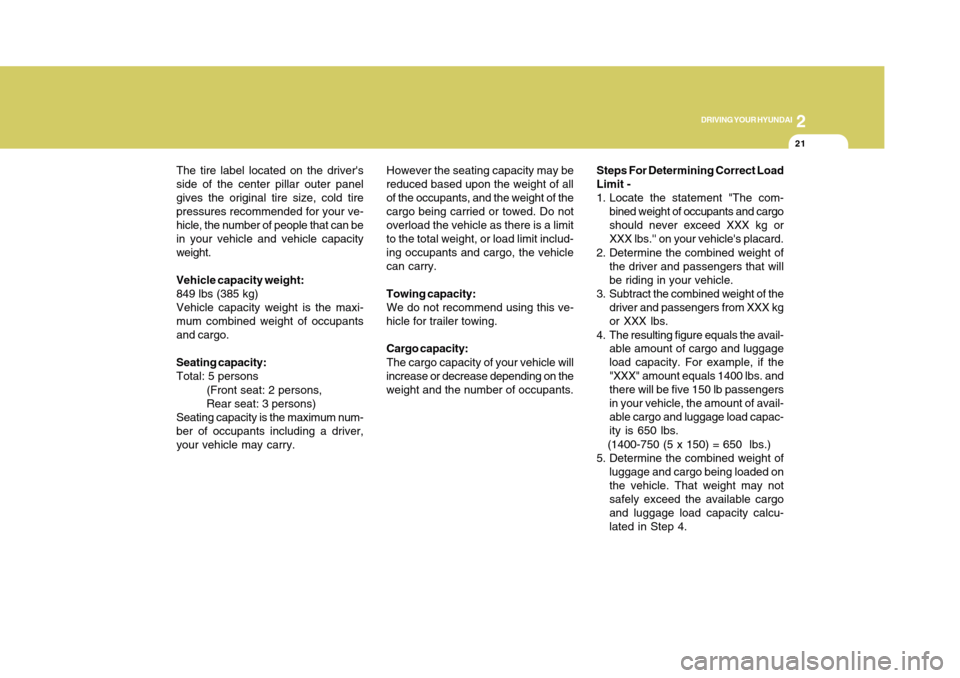
21
DRIVING YOUR HYUNDAI
2
Steps For Determining Correct Load
Limit -
1. Locate the statement "The com-
bined weight of occupants and cargo
should never exceed XXX kg or
XXX lbs.'' on your vehicle's placard.
2. Determine the combined weight of
the driver and passengers that will
be riding in your vehicle.
3. Subtract the combined weight of the
driver and passengers from XXX kg
or XXX lbs.
4. The resulting figure equals the avail-
able amount of cargo and luggage
load capacity. For example, if the
"XXX" amount equals 1400 lbs. and
there will be five 150 lb passengers
in your vehicle, the amount of avail-
able cargo and luggage load capac-
ity is 650 lbs.
(1400-750 (5 x 150) = 650 lbs.)
5. Determine the combined weight of
luggage and cargo being loaded on
the vehicle. That weight may not
safely exceed the available cargo
and luggage load capacity calcu-
lated in Step 4. The tire label located on the driver's
side of the center pillar outer panel
gives the original tire size, cold tire
pressures recommended for your ve-
hicle, the number of people that can be
in your vehicle and vehicle capacity
weight.
Vehicle capacity weight:
849 lbs (385 kg)
Vehicle capacity weight is the maxi-
mum combined weight of occupants
and cargo.
Seating capacity:
Total: 5 persons
(Front seat: 2 persons,
Rear seat: 3 persons)
Seating capacity is the maximum num-
ber of occupants including a driver,
your vehicle may carry.However the seating capacity may be
reduced based upon the weight of all
of the occupants, and the weight of the
cargo being carried or towed. Do not
overload the vehicle as there is a limit
to the total weight, or load limit includ-
ing occupants and cargo, the vehicle
can carry.
Towing capacity:
We do not recommend using this ve-
hicle for trailer towing.
Cargo capacity:
The cargo capacity of your vehicle will
increase or decrease depending on the
weight and the number of occupants.
Page 178 of 282
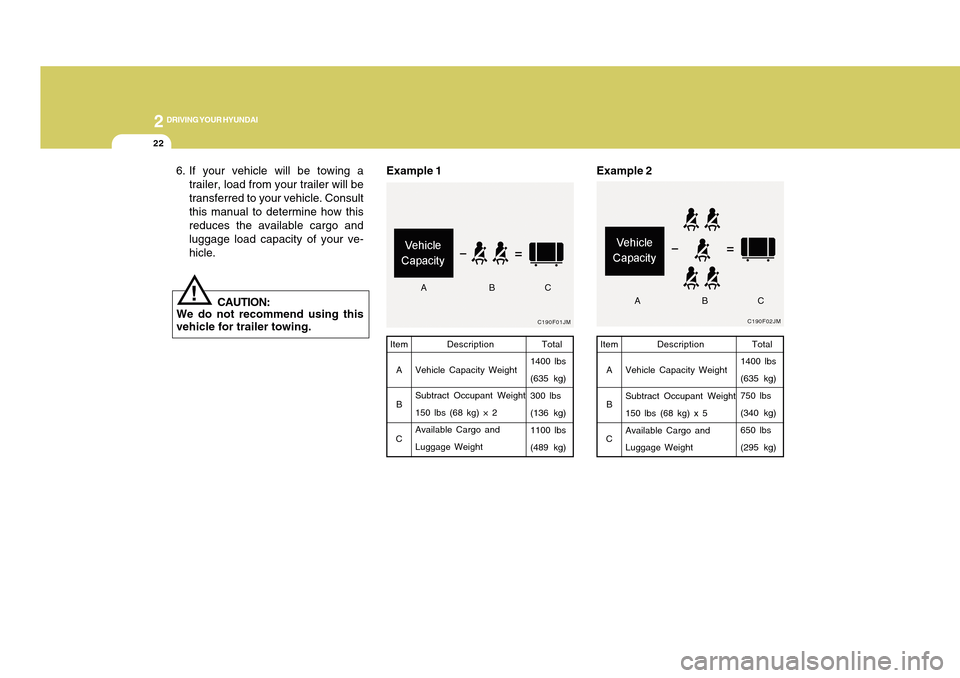
2
DRIVING YOUR HYUNDAI
22
C190F01JMTotal
1400 lbs
(635 kg)
300 lbs
(136 kg)
1100 lbs
(489 kg)
Example 1Item
A
B
CDescription
Vehicle Capacity Weight
Subtract Occupant Weight
150 lbs (68 kg) × 2
Available Cargo and
Luggage Weight
ABC
6. If your vehicle will be towing a
trailer, load from your trailer will be
transferred to your vehicle. Consult
this manual to determine how this
reduces the available cargo and
luggage load capacity of your ve-
hicle.
!
C190F02JM
Example 2
Total
1400 lbs
(635 kg)
750 lbs
(340 kg)
650 lbs
(295 kg) Item
A
B
CDescription
Vehicle Capacity Weight
Subtract Occupant Weight
150 lbs (68 kg) x 5
Available Cargo and
Luggage Weight
AB
C
CAUTION:
We do not recommend using this
vehicle for trailer towing.
Page 214 of 282

5
VEHICLE MAINTENANCE REQUIREMENTS6
DRIVING
CONDITION MAINTENANCE
INTERVALS
ENGINE OIL AND FILTER
AIR CLEANER FILTER
SPARK PLUGS
FRONT BRAKE DISC/PADS, CALIPERS
REAR BRAKE DRUMS/LININGS
PARKING BRAKE
STEERING GEAR BOX, LINKAGE
& BOOTS/LOWER ARM BALL JOINT
DRIVESHAFTS AND BOOTS
TIMING BELT
MANUAL TRANSAXLE OIL
AUTOMATIC TRANSAXLE FLUID
CLIMATE CONTROL AIR FILTER
R
R
R
I
I
I
I
I
R
R
R
R MAINTENANCE
OPERATION MAINTENANCE ITEM
EVERY 3,750 MILES (6,000 KM) OR 6 MONTHS
MORE FREQUENTLY
MORE FREQUENTLY
MORE FREQUENTLY
MORE FREQUENTLY
MORE FREQUENTLY
MORE FREQUENTLY
EVERY 7,500 MILES (12,000 KM) OR 6 MONTHS
EVERY 60,000 MILES OR 72 MONTHS
EVERY 80,000 MILES (120,000 KM)
EVERY 60,000 MILES (96,000 KM)
MORE FREQUENTLY
SEVERE DRIVING CONDITIONSA - Repeatedly driving short distance of less than 5miles (8km) in normal
temperature or less than 10miles (16km) in freezing temperature
B - Extensive engine idling or low speed driving for long distances
C - Driving on rough, dusty, muddy, unpaved, graveled or salt- spread roads
D - Driving in areas using salt or other corrosive materials or in very cold
weatherE - Driving in sandy areas
F - Driving in heavy traffic area over 90°F (32°C)
G - Driving on uphill, downhill, or mountain road
H - Towing a Trailer, or using a camper, or roof rack
I - Driving as a patrol car, taxi, other commercial use or vehicle
towing
J - Driving over 100 MPH (170 Km/h)
K - Frequently driving in stop-and-go conditionsA, B, C, D, E, F, G, H, I, K
C, E
B, H
C, D, G, H
C, D, G, H
C, D, G, H
C, D, E, F, G, H, I
C, E, F
B, C, D, E, F, G, I
A, C, D, E, F, G, H, I, J
A, C, E, F, G, H, I
C, EMAINTENANCE UNDER SEVERE USAGE CONDITIONSF040A02MC-AATThe following items must be serviced more frequently on cars normally used under severe driving conditions. Refer to the chart below
for the appropriate maintenance intervals.
R : Replace I : Inspect and, after inspection, clean, adjust, repair or replace if necessary
Page 281 of 282
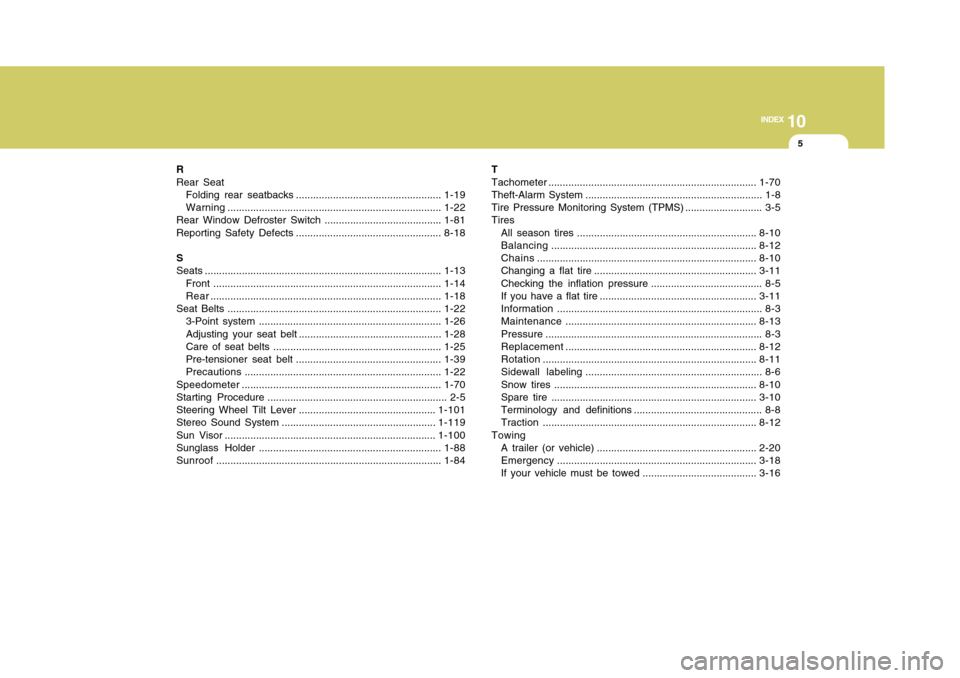
10
INDEX
5
R
Rear Seat
Folding rear seatbacks ...................................................1-19
Warning...........................................................................1-22
Rear Window Defroster Switch .........................................1-81
Reporting Safety Defects ...................................................8-18
S
Seats ...................................................................................1-13
Front ................................................................................1-14
Rear.................................................................................1-18
Seat Belts ...........................................................................1-22
3-Point system ................................................................1-26
Adjusting your seat belt ..................................................1-28
Care of seat belts ...........................................................1-25
Pre-tensioner seat belt ...................................................1-39
Precautions.....................................................................1-22
Speedometer......................................................................1-70
Starting Procedure ............................................................... 2-5
Steering Wheel Tilt Lever ................................................1-101
Stereo Sound System ......................................................1-119
Sun Visor ..........................................................................1-100
Sunglass Holder ................................................................1-88
Sunroof...............................................................................1-84T
Tachometer.........................................................................1-70
Theft-Alarm System .............................................................. 1-8
Tire Pressure Monitoring System (TPMS) ........................... 3-5
Tires
All season tires ...............................................................8-10
Balancing........................................................................8-12
Chains.............................................................................8-10
Changing a flat tire .........................................................3-11
Checking the inflation pressure ....................................... 8-5
If you have a flat tire .......................................................3-11
Information........................................................................ 8-3
Maintenance...................................................................8-13
Pressure............................................................................ 8-3
Replacement...................................................................8-12
Rotation...........................................................................8-11
Sidewall labeling.............................................................. 8-6
Snow tires .......................................................................8-10
Spare tire ........................................................................3-10
Terminology and definitions ............................................. 8-8
Traction...........................................................................8-12
Towing
A trailer (or vehicle) ........................................................2-20
Emergency......................................................................3-18
If your vehicle must be towed ........................................3-16